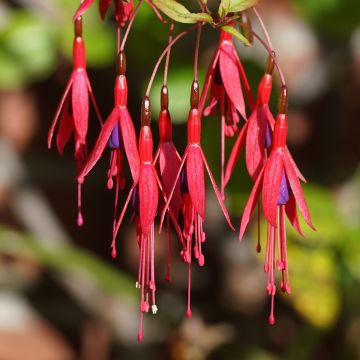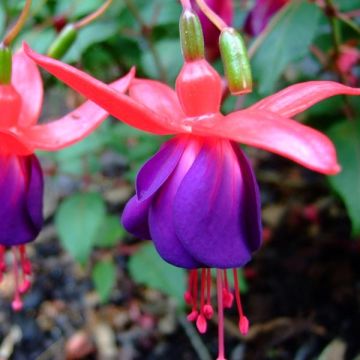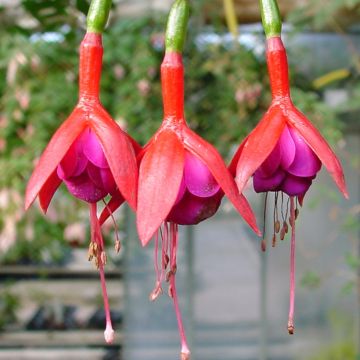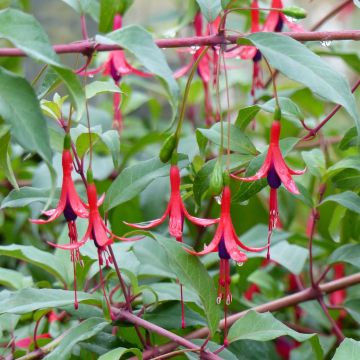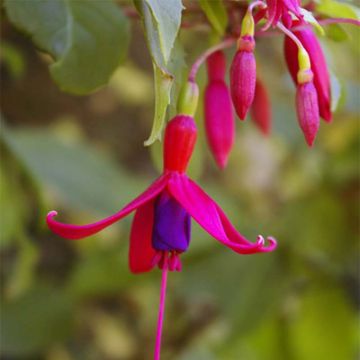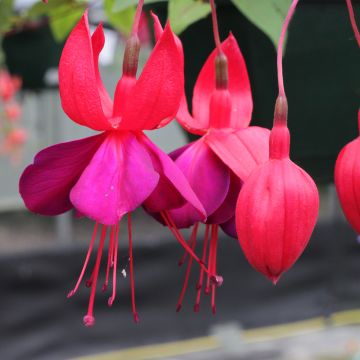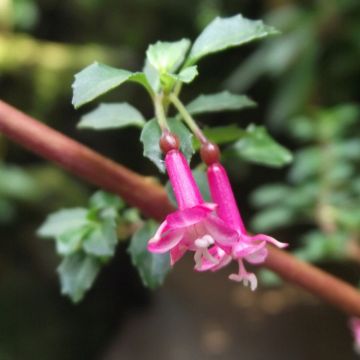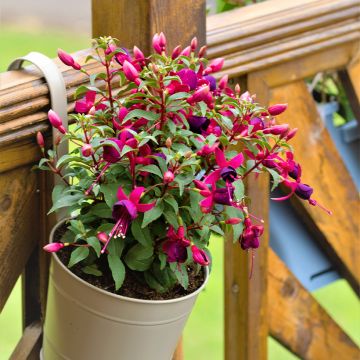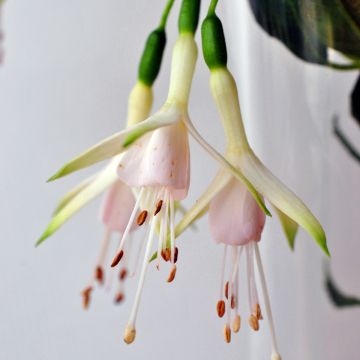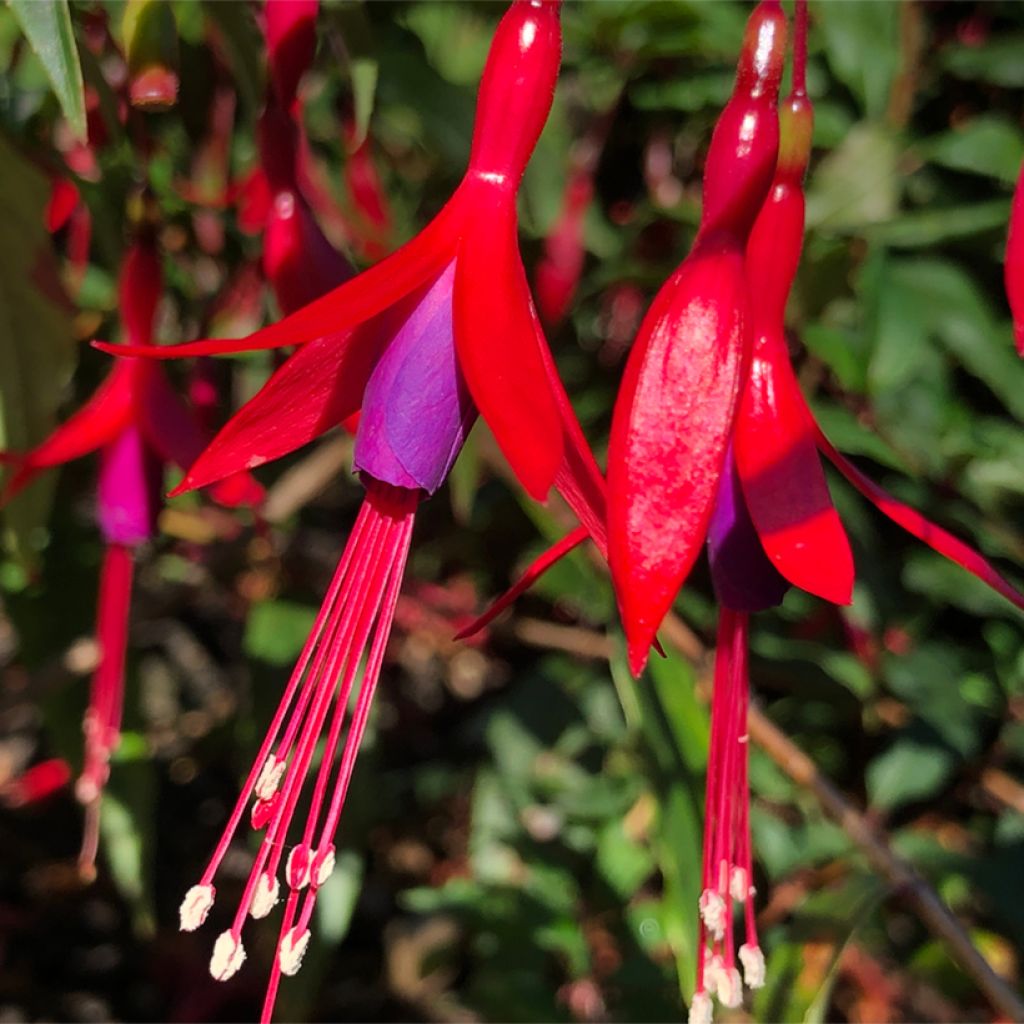

Fuchsia hatschbachii
Fuchsia hatschbachii
Fuchsia hatschbachii
Hatschbach's fuchsia
This item cannot be shipped to the selected country
Delivery charge from €5.90
More information
Schedule delivery date,
and select date in basket
This plant carries a 24 months recovery warranty
More information
We guarantee the quality of our plants for a full growing cycle, and will replace at our expense any plant that fails to recover under normal climatic and planting conditions.
From €5.90 for pickup delivery and €6.90 for home delivery
Express home delivery from €8.90.
Does this plant fit my garden?
Set up your Plantfit profile →
Description
Fuchsia hatschbachii, or Hatschbach's Fuchsia, is a bushy botanical species with summer flowering composed of hundreds of small tubular flowers which are red on the outside and purple in the centre. It forms a large climbing shrub with rapid growth and a flexible and trailing habit. It can reach up to 2.5m high. Place it in a semi-shaded exposure, in moist soil.
Fuchsia hatschbachii is a botanical species native to high-altitude areas in Brazil, belonging to the Onagraceae family. This upright shrub is sometimes considered a climbing plant due to its remarkable vigour. It can reach a height of 2.5m, or even more if winter does not cut back its vegetation, if the atmosphere remains humid and temperate, and the soil is fertile but well-drained. In cool climates, it generally reaches 1m high and 75cm wide. Its young red branches develop rapidly in spring, bearing small oval and elliptical leaves with slightly toothed edges along their entire length. They are shiny and a beautiful dark green providing a nice background for the flowers. These small flowers are numerous and bloom from June to October in the axils of the leaves, swaying in the wind at the end of slender stems. They consist of a long fleshy calyx with four thick red sepals, tapering to a point, which arch upwards when fully open. This 'underskirt' is topped by a corolla of violet petals from which long red stamens emerge.
Fuchsia hatschbachii shows good cold resistance, allowing it to be grown in the ground in almost all regions, with winter protection in the coldest areas. Its long branches can be trained against a wall or on a pergola, but as the plant does not have specific organs to cling with, it is necessary to espalier or support it, as with a climbing rose. It can also be left to grow naturally as a bush with large flexible branches. The flowers of this variety are delicate and fine; it is important not to drown them in an abundance of flowers that would overshadow their beauty. This fuchsia is enhanced by foliage plants with similar growing requirements, such as botanical hydrangeas, cimicifugas, ferns, rodgersias, or hostas.
Report an error about the product description
Plant habit
Flowering
Foliage
Botanical data
Fuchsia
hatschbachii
Onagraceae
Hatschbach's fuchsia
South America
Other Perennial Fuchsia
Planting and care
Fuchsia hatschbachii thrives in shade or partial shade in moist, rather fertile, slightly acidic soil that is light and well-drained, retaining moisture in the summer. It does not like scorching sun or soils which are waterlogged in winter. Morning sun is well tolerated. You can add some gravel to the bottom of the planting hole.
Its leaves are deciduous as soon as the temperature drops to -5°C and its stems droop below -10°C. However, if your climate is harsher and the frosts are intense, the stems will not survive, which will not kill your Fuchsia. You can prune them and protect the crown by mulching or mounding soil around it. The stems will regrow vigorously in spring. You can prune the stems again if necessary in early spring, removing any dead parts. An annual pruning after flowering stimulates growth and promotes flowering the following year.
Planting period
Intended location
Care
This item has not been reviewed yet - be the first to leave a review about it.
Haven't found what you were looking for?
Hardiness is the lowest winter temperature a plant can endure without suffering serious damage or even dying. However, hardiness is affected by location (a sheltered area, such as a patio), protection (winter cover) and soil type (hardiness is improved by well-drained soil).

Photo Sharing Terms & Conditions
In order to encourage gardeners to interact and share their experiences, Promesse de fleurs offers various media enabling content to be uploaded onto its Site - in particular via the ‘Photo sharing’ module.
The User agrees to refrain from:
- Posting any content that is illegal, prejudicial, insulting, racist, inciteful to hatred, revisionist, contrary to public decency, that infringes on privacy or on the privacy rights of third parties, in particular the publicity rights of persons and goods, intellectual property rights, or the right to privacy.
- Submitting content on behalf of a third party;
- Impersonate the identity of a third party and/or publish any personal information about a third party;
In general, the User undertakes to refrain from any unethical behaviour.
All Content (in particular text, comments, files, images, photos, videos, creative works, etc.), which may be subject to property or intellectual property rights, image or other private rights, shall remain the property of the User, subject to the limited rights granted by the terms of the licence granted by Promesse de fleurs as stated below. Users are at liberty to publish or not to publish such Content on the Site, notably via the ‘Photo Sharing’ facility, and accept that this Content shall be made public and freely accessible, notably on the Internet.
Users further acknowledge, undertake to have ,and guarantee that they hold all necessary rights and permissions to publish such material on the Site, in particular with regard to the legislation in force pertaining to any privacy, property, intellectual property, image, or contractual rights, or rights of any other nature. By publishing such Content on the Site, Users acknowledge accepting full liability as publishers of the Content within the meaning of the law, and grant Promesse de fleurs, free of charge, an inclusive, worldwide licence for the said Content for the entire duration of its publication, including all reproduction, representation, up/downloading, displaying, performing, transmission, and storage rights.
Users also grant permission for their name to be linked to the Content and accept that this link may not always be made available.
By engaging in posting material, Users consent to their Content becoming automatically accessible on the Internet, in particular on other sites and/or blogs and/or web pages of the Promesse de fleurs site, including in particular social pages and the Promesse de fleurs catalogue.
Users may secure the removal of entrusted content free of charge by issuing a simple request via our contact form.
The flowering period indicated on our website applies to countries and regions located in USDA zone 8 (France, the United Kingdom, Ireland, the Netherlands, etc.)
It will vary according to where you live:
- In zones 9 to 10 (Italy, Spain, Greece, etc.), flowering will occur about 2 to 4 weeks earlier.
- In zones 6 to 7 (Germany, Poland, Slovenia, and lower mountainous regions), flowering will be delayed by 2 to 3 weeks.
- In zone 5 (Central Europe, Scandinavia), blooming will be delayed by 3 to 5 weeks.
In temperate climates, pruning of spring-flowering shrubs (forsythia, spireas, etc.) should be done just after flowering.
Pruning of summer-flowering shrubs (Indian Lilac, Perovskia, etc.) can be done in winter or spring.
In cold regions as well as with frost-sensitive plants, avoid pruning too early when severe frosts may still occur.
The planting period indicated on our website applies to countries and regions located in USDA zone 8 (France, United Kingdom, Ireland, Netherlands).
It will vary according to where you live:
- In Mediterranean zones (Marseille, Madrid, Milan, etc.), autumn and winter are the best planting periods.
- In continental zones (Strasbourg, Munich, Vienna, etc.), delay planting by 2 to 3 weeks in spring and bring it forward by 2 to 4 weeks in autumn.
- In mountainous regions (the Alps, Pyrenees, Carpathians, etc.), it is best to plant in late spring (May-June) or late summer (August-September).
The harvesting period indicated on our website applies to countries and regions in USDA zone 8 (France, England, Ireland, the Netherlands).
In colder areas (Scandinavia, Poland, Austria...) fruit and vegetable harvests are likely to be delayed by 3-4 weeks.
In warmer areas (Italy, Spain, Greece, etc.), harvesting will probably take place earlier, depending on weather conditions.
The sowing periods indicated on our website apply to countries and regions within USDA Zone 8 (France, UK, Ireland, Netherlands).
In colder areas (Scandinavia, Poland, Austria...), delay any outdoor sowing by 3-4 weeks, or sow under glass.
In warmer climes (Italy, Spain, Greece, etc.), bring outdoor sowing forward by a few weeks.

































